With the advancement of digital storage solutions, services like pCloud have made managing and securing data easier. One of its significant features is automatic uploads that automatically back up files. However, such apps sometimes encounter issues that disrupt convenience. If there is any issue with automatic uploads, you may need to back up your files by yourself regularly. Creating backups manually after a few days may be frustrating.
This article from EaseUS helps you with a few reasons why your pCloud automatic upload not working. A step-by-step solution guide will help you get your automatic uploads back on track
An Overview of pCloud Automatic Upload
The automatic upload feature of pCloud keeps your files backed up and accessible. With automatic upload, users can easily sync photos, videos, and other files from their devices to pCloud account. In addition to updating data and making it available across multiple platforms, it minimizes the risk of data loss.

Why pCloud Automatic Upload Not Working Normally
The pCloud's automatic upload feature may not work due to the following reasons.
- Network Connection: An unstable or poor network connection can disrupt the automatic upload process. It interrupts the uploads and prevents files from syncing to your pCloud account.
- App Permissions: If the pCloud app doesn't have the necessary permissions to access your files and media, it won't be able to upload automatically.
- Storage Limit: When your pCloud account reaches its storage capacity, the automatic upload feature may stop functioning until you free up space.
- App Version: Using an outdated version of the pCloud app can cause compatibility issues, which stops automatic uploads.
You may also want to see:
SOLVED: pCloud Automatic Upload Not Working
- 1. Network Connection Issue
- 2. App Permissions Problem
- 3. Storage Limit Reached
- 4. Outdated App Version
1. Network Connection Issue
If your automatic uploads fail due to poor network connectivity, follow these steps to tackle the problem:
- Check Network Connectivity: Make sure you have a stable internet connection. Check your Wi-Fi/mobile data connectivity.
- Retry Automatic Upload: If there is any connectivity issue, upload the files again. A stable network must ensure successful syncing.
2. App Permissions Problem
Sometimes the issue is with permissions. If the pCloud app is not allowed to access your files, it can't upload them automatically. Here are the steps to resolve this issue:
- Go to App Permissions: Open your device's settings and go to the "Apps" or "Application Manager" section.
- Find pCloud App: Scroll down the apps list and find "pCloud."
- Grant Permissions: Open "pCloud" and go to the "Permissions" section. Make sure that permissions, such as access to photos, media, and files, are enabled.
- Retry Automatic Upload: After allowing permissions, return to the pCloud app and try to attempt an automatic upload again.
3. Storage Limit Reached
When your pCloud storage is full, you must create space for starting an automatic upload. Follow these steps to address the storage limit issue:
- Check Storage Usage: Log in to your pCloud account and check your space available.
- Free Up Space: Delete unnecessary files or move them to another location.
- Retry Automatic Upload: After creating enough space, start the automatic upload process again
4. Outdated App Version
Using an outdated pCloud app version can lead to compatibility issues. To solve this, follow these steps:
- Update the App: Open your device's app store.
- Check for Updates: Search for "pCloud" and check for available updates.
- Update the App: If an update is available, click "Update" to install the latest version.
- Retry Automatic Upload: Retry the automatic upload process after updating the app.
Share it with your friends and family to help them out too:
How to Backup Files to pCloud Without Automatic Upload
If the automatic upload is not working, it doesn't mean you can compromise on data security and accessibility. It opens your path to a more tailored and controlled backup process. One of the most effective methods to back up files to pCloud is using cloud backup software.
Secure Download
"EaseUS Todo Backup Home" offers an excellent alternative that empowers you to upload and store your files on pCloud with precision and ease. This exclusive backup solution is designed to cater to your specific backup needs. With an intuitive interface and powerful features, it ensures that your data remains protected.
Key Features of EaseUS Todo Backup
- Customized scheduling: You can set when to upload your files automatically, daily, weekly, or on specific dates.
- Differential and incremental backup: It updates the modifications from the new same file to previously backed up files thud minimizing backup time and storage consumption
- Encryption and compression: Protect your sensitive data with encryption and compress files to optimize storage.
- Disk cloning and system migration: Easily transfer your operating system to a new disk or computer. Users can upload all their data, including settings and programs.
- Cloud backup: Back up your files to cloud storage services like pCloud, ensuring off-site data redundancy.
- Create and restore system image: Create a Windows system image and restore it to a new computer without reinstallation.
With EaseUS Todo Backup, you can manage the files that matter most. From personal documents to essential work files, you can handle them easily. Whether you're looking for a solution to automatic upload not working or seeking a versatile backup strategy, EaseUS Todo Backup has you covered. After downloading it, you can follow the steps below to back up your files to pCloud:
Step 1. To start backup, click the Select backup contents.

Step 2. There are four data backup categories: File, Disk, OS, and Mail.

Step 3. On the left-hand side, you'll see a list of local and network files. Selecting the files to be backed up by expanding the directory.

Step 4. Follow the instructions on the screen and pick the location where you wish to store the backup.
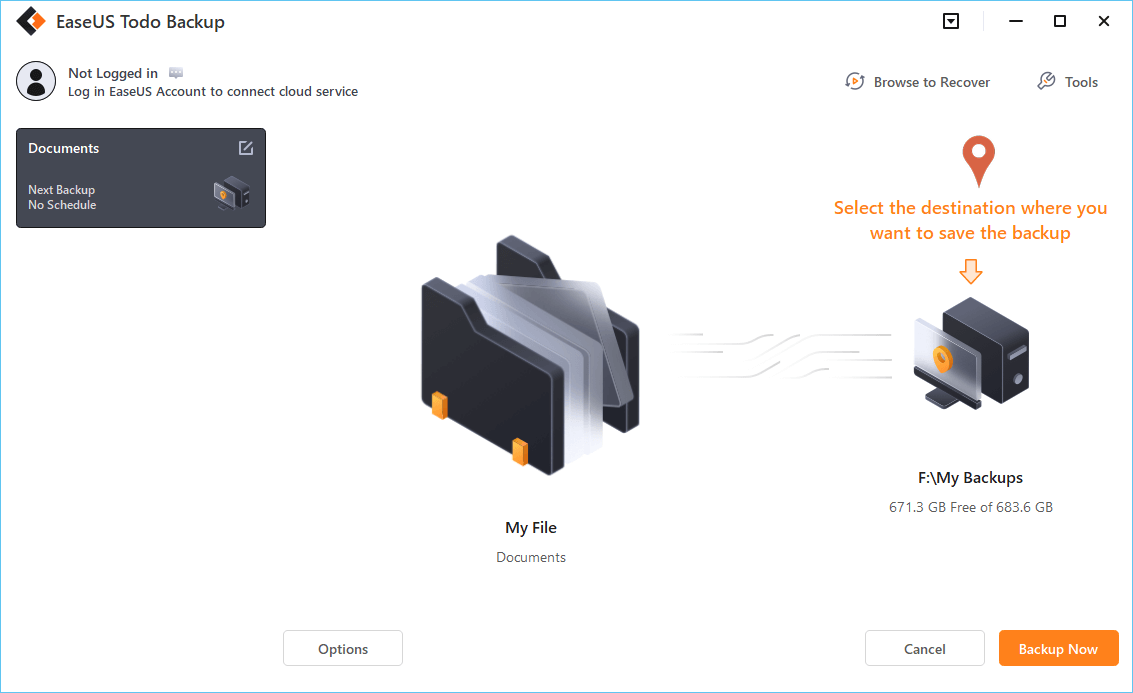
In Backup Options, click Options to encrypt the backup with a password, specify the backup schedule, and choose whether or not to start the backup at a certain event in Backup Scheme. There are a variety of customizable features available for you to explore, and you may tailor the backup operation to meet your specific requirements.
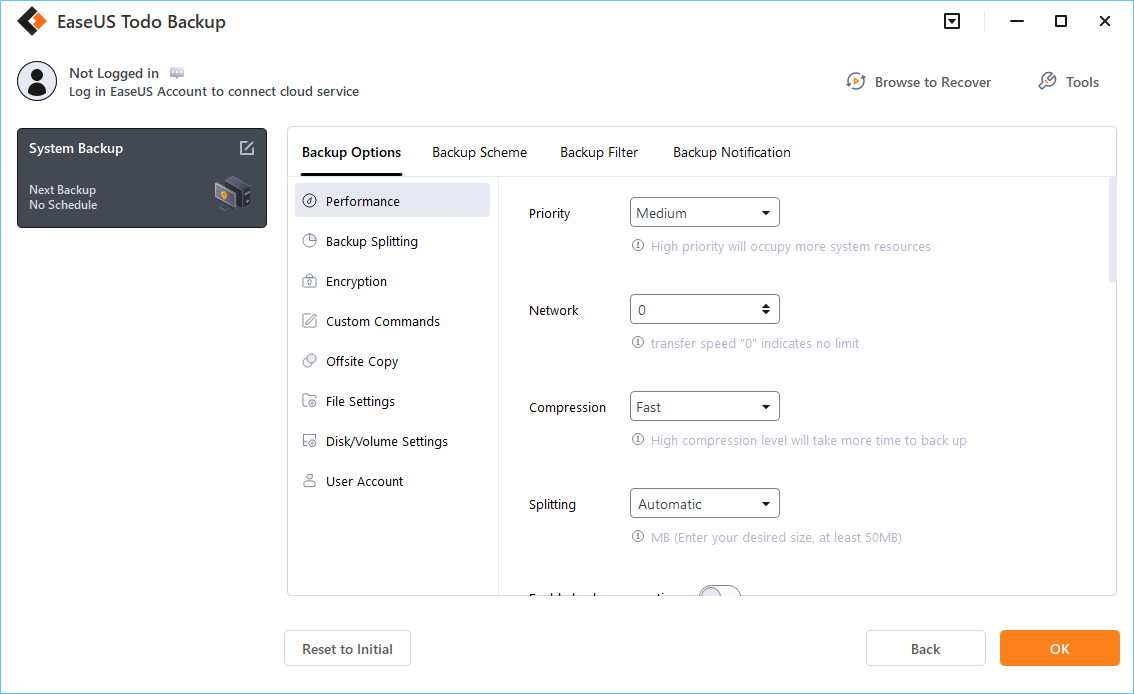
Step 5. Backups can be stored on a local disk, in EaseUS's cloud service, or on a network attached storage device (NAS).

Step 6. EaseUS Todo Backup allows customers to back up data to a third-party cloud drive or the company's own cloud storage.
If you wish to back up your data to a third-party cloud drive, select Local Drive, scroll down to add Cloud Device and enter your account information.
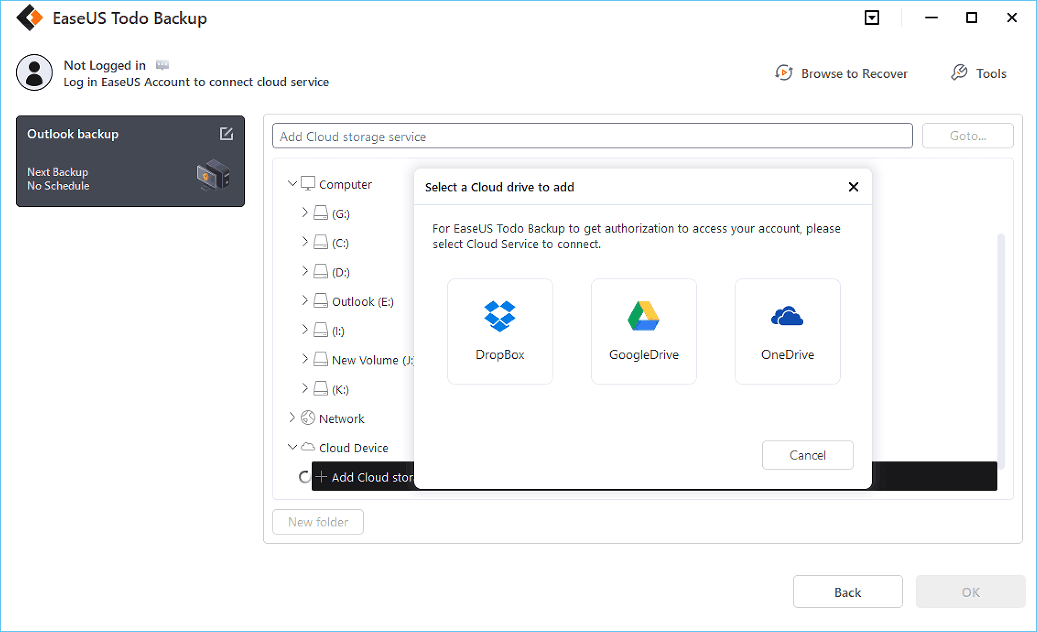
You may also use EaseUS's own cloud storage service. Click EaseUS Cloud, create an account using your EaseUS Account, then log in to your account.
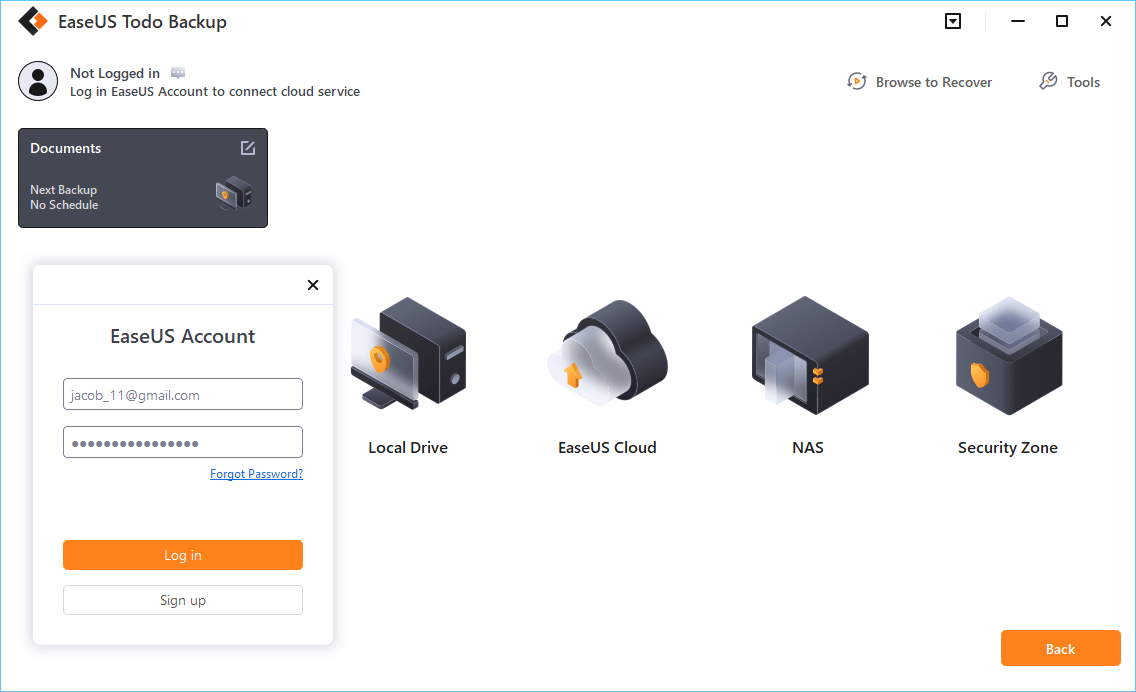
Step 7. To begin a backup, choose Backup Now. It will appear in the shape of a card on the left-hand panel when the backup process has been successfully finished. To handle the backup job in more detail, right-click on it.
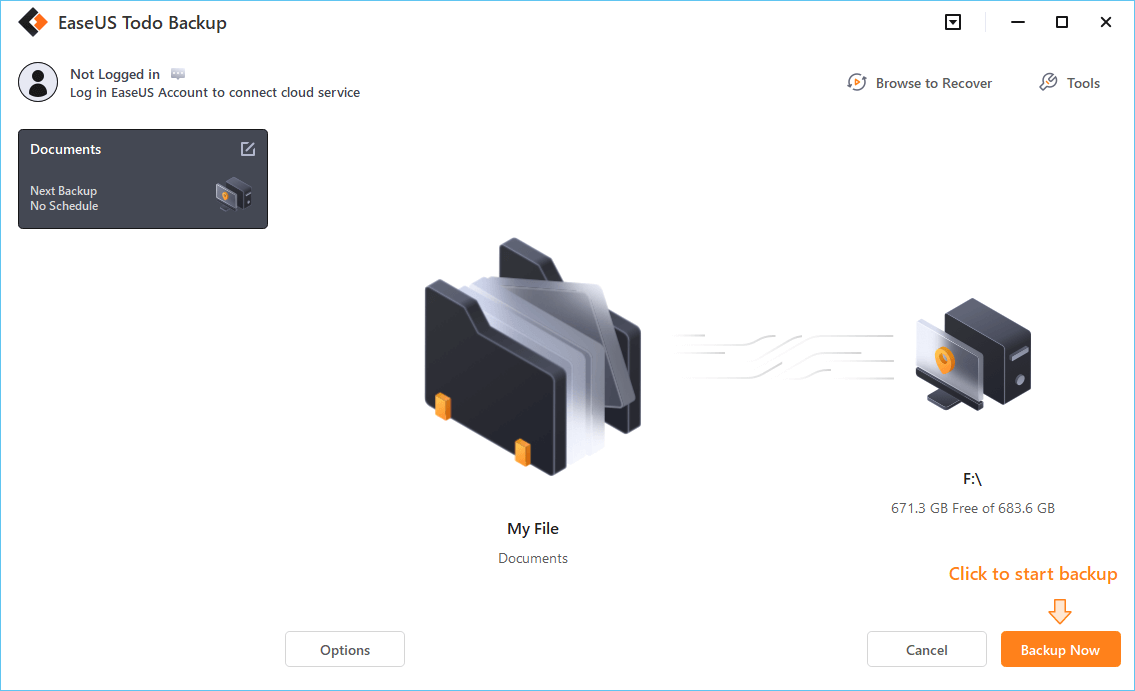
The Wrap Up
In the world of digital file management, unexpected issues can disrupt our workflow. However, you can easily solve the problems by understanding why pCloud automatic upload is not working and their solutions. If you're looking for an effective as well as secure method to back up data to cloud, consider using EaseUS Todo Backup Home. Whether you need help with network connectivity, app permissions, storage limits, or outdated apps, EaseUS can help. It is one of the most reliable and secure apps to upload data automatically. In addition to catering to all your backup needs, it ensures your data's safety and accessibility.
Secure Download
FAQs on pCloud Automatic Upload Not Working
1. Why does pCloud take so long to upload?
The upload speed depends on factors such as your internet connection, file size, and the overall load on the pCloud servers. Optimize your network connectivity for faster uploads if your file size is small and still takes time. Also, check if there is space available on pCloud.
2. How do I force auto upload on pCloud?
To force auto upload, ensure that pCloud has the necessary permissions. Ensure the app accesses the files you want to upload automatically.
- Go to the pCloud app settings.
- Look for an option for background refresh or synchronization. Turn it on to allow the app to check the new files regularly.
- Allow the automatic upload over Wi-Fi/mobile data.
- Ensure your battery-saving mode doesn't restrict background activities, which could affect auto upload.
- Check if your device offers account sync settings and ensure your pCloud account is set to sync regularly.
3. How long should it take to upload 1GB?
The upload time for 1GB of data depends on your internet speed. A standard broadband connection might take around 5-10 minutes for a 1GB file to upload.
Was This Page Helpful?
"I hope my articles can help solve your technical problems. If you are interested in other articles, you can check the articles at the bottom of this page, and you can also check my Facebook to get additional help."
Written by Larissa
Larissa has rich experience in writing technical articles and is now a professional editor at EaseUS. She is good at writing articles about data recovery, disk cloning, disk partitioning, data backup, and other related knowledge. Her detailed and ultimate guides help users find effective solutions to their problems. She is fond of traveling, reading, and riding in her spare time.
Related Articles
-
Fix CS:GO "VAC Was Unable to Verify Your Game Session"
![author icon]() Daisy/2024-01-11
Daisy/2024-01-11 -
Full Guide to Fix Windows 10 Slow Boot After Update
![author icon]() Jean/2024-01-11
Jean/2024-01-11 -
How to Fix Palworld Black Screen on Launch - Xbox/PC/Steam
![author icon]() Sherly/2024-02-20
Sherly/2024-02-20 -
A Complete Guide to macOS Big Sur Download and Install (Version 11)
![author icon]() Brithny/2024-01-11
Brithny/2024-01-11
EaseUS Data Recovery Services
EaseUS data recovery experts have uneaqualed expertise to repair disks/systems and salvage data from all devices like RAID, HDD, SSD, USB, etc.
